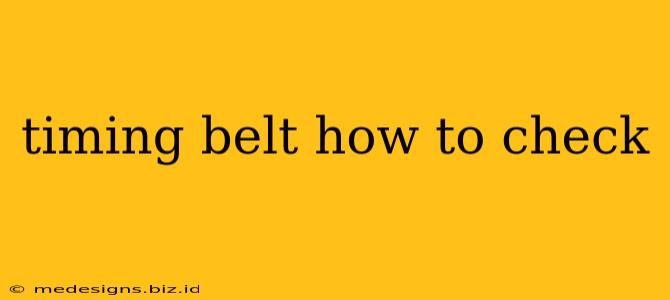Regular maintenance is crucial for keeping your vehicle running smoothly, and checking your timing belt is a vital part of that process. Ignoring this seemingly small component can lead to catastrophic engine damage, so knowing how to check your timing belt's condition is essential. This guide will walk you through how to inspect your timing belt and help you determine when it's time for a replacement.
Understanding Your Timing Belt
Before diving into the inspection process, it's important to understand what a timing belt does. The timing belt synchronizes the rotation of the crankshaft and camshaft(s), ensuring your engine's valves open and close at precisely the right moments. If the timing belt breaks, the valves can collide with the pistons, leading to severe and costly engine damage. This is why regular checks are so critical.
Visual Inspection: The First Step
The easiest way to check your timing belt is through a visual inspection. This doesn't require specialized tools and can help you identify obvious problems.
What to Look For:
- Cracks: Look closely for any cracks or fissures in the belt's surface. Even small cracks can indicate weakening and potential failure.
- Fraying: Fraying at the edges or on the teeth suggests significant wear and tear.
- Glazing: A glazed or shiny appearance indicates excessive heat and friction, signaling potential problems.
- Missing Teeth: Check carefully for any missing teeth or significant wear on the belt's teeth. These are clear indicators of a worn-out belt.
- Oil or Grease: The presence of oil or grease on the belt can point to a leak that needs immediate attention. This is a serious issue because oil can degrade the rubber and lead to premature failure.
- Belt Alignment: Observe the alignment of the belt. It should run smoothly and evenly across all pulleys. Misalignment can cause uneven wear and premature failure.
Important Note: A visual inspection alone isn't enough to definitively determine the health of your timing belt. While it can highlight obvious problems, a thorough inspection often requires more involved techniques.
Beyond Visual Inspection: When Professional Help is Needed
While a visual inspection provides a good starting point, it's crucial to understand its limitations. Factors like belt tension and internal degradation aren't visible to the naked eye. Therefore, relying solely on a visual check is not sufficient.
When should you consult a professional?
- Age and Mileage: Consult your vehicle's owner's manual for the recommended replacement interval based on age and mileage. This is often the most crucial factor in determining when a replacement is necessary. Ignoring the manufacturer's recommendations can be risky.
- Suspected Damage: If you've noticed any of the issues mentioned above (cracks, fraying, glazing, etc.), it's vital to have a mechanic inspect your timing belt.
- Unusual Noises: Unusual squeaking or squealing noises from the engine compartment could be a sign of a failing timing belt.
- Regular Maintenance: As part of your routine vehicle maintenance, scheduling a timing belt inspection with a qualified mechanic is highly recommended. They have the tools and expertise to perform a thorough assessment.
Replacing Your Timing Belt: A Crucial Decision
Replacing a timing belt is a significant undertaking that usually requires specialized tools and expertise. It's highly recommended to entrust this job to a qualified mechanic, as incorrect installation can lead to serious engine damage.
Remember, the timing belt is a critical engine component. Regular checks, combined with professional inspections based on age and mileage, are crucial to preventing expensive and potentially catastrophic engine failure. Don't hesitate to seek professional help if you have any concerns about your timing belt's condition.
